There is no one best strike indicator under all conditions. What works well on a spring creek, will likely struggle on a boisterous freestone river. In all honestly, I rarely fish indicators, but sometimes they are essential. A necessary evil. Some nymphs are simply too heavy to suspend under a dry fly hence the need for indicators.
I have three favorite indicators..
When buoyancy and visibility are paramount, for example when fishing big, fast waters or heavy flies which is quite typical of many of the fisheries out West, I rate the Oros strike indicator.
When stealth, and zero disturbance is key. Such as when fishing a heavily pressured spring creek. I like using yarn indicators; they barely create a ripple on landing and to the fish they look like something natural. Also a good choice for any still water fishing.
If I want a foot in both camps, for example when fishing mountain creeks where the water does not have much power or depth. I like the CorQs, they float well, and look very natural. Keep reading to find out in more detail why I have these preferences.
My experience, what I base my opinion on
I have been fly fishing for over twenty years and have been writing about it for nearly as long. During this time, I have fished with and trailed many different strike indicators.
I will list my four favorite indicators for most fishing situations and will also provide four runner-ups.
Key factors to consider when selecting a strike indicator.
- Buoyancy: The indicator should maintain buoyancy on the water’s surface.
- Visibility: It should be easily visible to track the fly’s movement.
- Fish Wariness: Choose indicators that don’t startle or spook wary fish.
- Durability: Look for indicators that remain buoyant after repeated use and submersion.
- Easy Attachment: The indicator should be simple to attach to the line. At the same time it should not come off during the cast.
- Drag Minimization: Minimize drag during casting and on the water’s surface.
- Castability: Opt for indicators that are easy to cast, avoiding larger or off-center options.
- Adjustability: The indicator should allow for easy positioning at varying water depths.
My recommendations for the best fly-fishing indicators.
Editor’s Choice: CorQs Strike Indicators
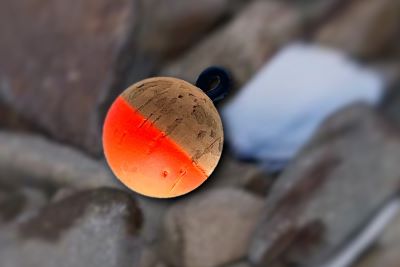
The CorQs indicator somehow escaped my memory when I first wrote my round-up of indicators. This is unfortunate because I hold them in high regards, although they can be challenging to find in stores.
I rare them highly for fishing spring creeks, streams, lake margins and smaller freestone rivers. Basically, anytime I am not fishing a double tungsten bead rig, or fishing pocket water among turbulent white water.
So why do I like them. Firstly, they are cork, or wood. Not plastic. I try to minimize the amount of plastic I fish with.
But they are also very good indicators, they are very buoyant. CorQ claim their cork is even more buoyant than synthetic indicators, although in my experience, both materials float equally well.
Additionally, due to their lightweight nature, CorQ indicators cast very well. Sure, not as well as cast but they are better than most other ball indicators. In terms of castability they are bettered only by the Oros indicators below.
The painted top of the CorQs is highly visible, while the bottom half of the CorQs is exposed cork.. From below, it appears like a piece of wood floating downstream. I reckon it must spook less fish than a big blob of orange plastic.
I must also mention the ease of use. Installing the CorQs is a simple process: push a loop of line through the rubber o-ring, up and over the ball, and then tighten the line. It is not a difficult task and being a single piece there is no fiddly small parts to lose.. and if you are anything like me, I can never find a dropped indicator screw among the pea gravel.
To remove the CorQs, is also very simple. Just create some slack in the line and reverse the procedure. It is certainly easier than tying and untying a knot, although not as user-friendly as the screw-mount methods used by the Oros or Airflow indicators.
No strike indicator is perfect, and the CorQs does have a slight issue with being off-center, causing some turbulence during the cast. This is a problem it shares with the Air-lock and Thingamabobber, although due to its lightness, I find it to be less problematic with the CorQs compared to the competition. Additionally, on very fine diameter leaders, it may slide along the line slightly after multiple casts.
If you’re seeking a highly buoyant, environmentally friendly, and very visible strike indicator, the CorQs is undoubtedly a front runner. Furthermore, its natural wood construction makes it slightly less threatening to wild trout compared to foam or plastic ball indicators.
| Buoyancy | 5/5 |
| Visibility | 5/5 |
| Stealth | 3/5 |
| Castability | 2/5 |
| Ease of use | 4/5 |
| Durability | 4.5/5 |
Best General Purpose: Oros strike indicator
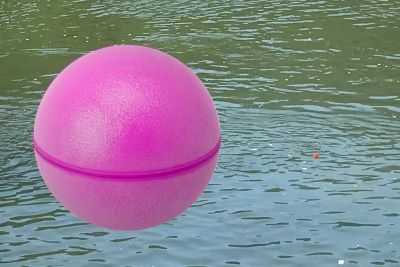
The Oros Strike is an impressive new strike indicator, and personally, I believe it to be the best foam/plastic indicator available. This innovative indicator splits in half, with one half acting as the bolt and the other as the nut.
I fish Oros indicators on big, fast-moving waters. Great option when fishing heavy nymphs that just want to pull my floating line under.
I like the Oros indicator more than the competition because the leader runs through a slit in the middle of the bolt half, allowing it to pass straight through the indicator. This streamlined setup provides better balance and reduces the chances of tangling—it’s nearly impossible to tangle it.
Consequently, there is less turbulence during the cast, making it easier to cast compared to alternatives like Thingamabobbers or Airlocks, which are connected on the side. In this aspect, the Oros Strike is a definite improvement over existing option. I use to like Airlocks, but now rarely fish. Oros does the same job but better.
Furthermore, they are incredibly user-friendly. To use them, simply unscrew the two halves, thread in the line, and tighten. If you need to change the position, loosen it slightly and reposition it along the line. However, it’s worth noting that on light tippet, the indicator may start to slip over time, but this is a common issue with most indicators.
As a foam ball indicator, it is well-suited for suspending weighted nymphs in turbulent water. It also boasts excellent visibility for both the angler and the fish.
One downside is that the Oros Strike tends to splash down fairly hard, making it less ideal for casting to wary wild fish in clear conditions. But then who fishes large ball indicators in such conditions. Much better to use yarn or simply a dropper beneath a dry fly.
The foam used in the Oros Strike incorporates a biodegradable plastic additive, which supposedly allows for faster decomposition compared to traditional foam. While this is a step in the right direction, it’s important to note that foam is still plastic, and in general, is still considered more polluting than wool or cork.
In summary, the Oros Strike indicator is a game changer. Its streamlined design makes casting significantly easier compared to traditional round ball indicators. When fishing in larger bodies of water, it is undoubtedly the best ball indicator available on the market.
| Buoyancy | 5/5 |
| Visibility | 5/5 |
| Stealth | 1/5 |
| Castabiltiy | 4.5/5 |
| Ease of use | 5/5 |
| Durability | 4.5/5 |
Best Finesse Indicator: Wool / Yarn

Plain wool makes an excellent indicator and it is my personal preference. It floats decently, casts well and lands gently without a splash.
A small wool indicator is no more difficult to cast than a dry fly. The reason, I like wool or yarn indicators more than any other is that they create minimal drag, this allows the nymph below the surface to control the drift and not the ‘indicator’ bobbing on the surface.
Unnatural drag scare trout and yarn creates less drag than any other indicator I have tried.
Attaching wool indicators can be a bit tricky and time-consuming, usually requiring a knot. My knot of choice is the Strike Indicator Loop knot. This knot makes it possible to change position without untying everything.
Many companies sell washed natural wool and synthetic yarn. It works okay, but can lack the natural oil so applying a few drops of floatant is almost essential to keep yarn floating. I grew up on a sheep farm, so I had a ready supply of natural wool which I still prefer over commercial yarn or washed wools.
One cost saving tip, Crafting stores often sell wool and yarn in bulk for the same price as a little sachet sold to fly fishermen. Due to the natural oils, I still prefer nature wool straight from the fence, but I admit this is hard to find in many countries.
Wool indicators are the best, and cheapest option for delicate presentations and minimal drag. A few times I have had trout raise and taken my indicator by mistake. Unless you are fishing for dumb stock trout, this will never happen with a foam ball.
| Buoyancy | 3/5 |
| Visibility | 4/5 |
| Stealth | 5/5 |
| Castabiltiy | 5/5 |
| Ease of use | 1/5 |
| Durability | 3/5 |
New Zealand Strike Indicator System
The New Zealand Strike Indicator is a system to quickly and easily apply wool/yarn indicators. This is a great time saver, eliminating knots meaning the yard is very simple to reposition along the line. A great time saver.
It maintains all of the same benefits as wool/yarn but at a higher price. If you plan to fish yarn indicators often, the added convenience, and time-saving means this tool is easy to recommend.
| Buoyancy | 3/5 |
| Visibility | 4/5 |
| Stealth | 5/5 |
| Castabiltiy | 5/5 |
| Ease of use | 4/5 |
| Durability | 3/5 |
The runners up – still good, but maybe not the best.
AIR-LOCK Strike Indicator
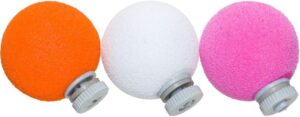
Air-Lock Strike Indicators were pretty revolutionary when they were released but the market has moved on.
They are made out of low-density foam. They are quick and easy to use and are a breeze to adjust. Simply unscrew the little end nut and lay the leader into the grove. Then lock everything in place by screwing the nut down tight. They come in three sizes (1/2”, 3/4”, and 1” sizes), and three colors (white, pink, and orange)
I find the lightweight foam indicators like the Air-lock to be easier to cast than the likes of a hard plastic Thingamabobber. In saying that, nothing beats a pinch of yarn. The larger sizes can be challenging to roll over in windy conditions. I also found it a bit difficult to smoothly roll cast. The nut jutting out can tangle the line at times.
It does attach to the line much more securely than the Thingmabobber, so a much better choice for fine diameter leaders because it almost never moves.
The grey locking nut assists to camouflage the indicator when floating overhead, but it is still going to spook wary wild brown trout. Stock trout rarely seem to care.
Apparently, they are now entirely biodegradable so losing one will not litter the environment with long lasting plastic, although I do find the plastic nuts are quite easy to drop and lose. If you really care about the environment it is still much better to use a cork or wool indicator.
Overall, Air Lock Strike indicators are very buoyant, reasonable to cast, and ideal for bigger water applications. They work fine, but I feel the newly released Oros indicator does the same role better.
| Buoyancy | 5/5 |
| Visibility | 5/5 |
| Stealth | 1.5/5 |
| Castabiltiy | 2/5 |
| Ease of use | 5/5 |
| Durability | 4/5 |
Thingamabobber
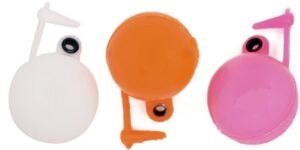
Thingamabobbers are hard plastic strike indicators. Due to their high level of buoyancy, they are very popular with big water anglers.
They are very visible and buoyant. Perfect for fishing heavy nymphs or large streamers through fast-flowing water. The weight does impact casting and in particular roll casting and can land quite heavily making an audible splash. These are not a strike indicator for precision casting.
As casting goes, they are not the best. They can kink the line slightly and due to the slightly heavier mass, this makes them difficult to roll over in windy conditions. I have also had them slide alone when used with extra fine tippet material.
I do not recommend them when conditions are low and clear. I personally do not use them in my local rivers, because the brown trout are wary having seen too much angling pressure. They will swim a mile the moment such an indicator splashes down. But, in big, slightly cloudy water with less wary fish, they are an excellent option.
Rigging is simple. Simply thread the leader through the hole in the Thingamabobber, and accurately position it. Then secure it in place by sliding the plastic pin into the hole. Once secure it is unlikely to move unless it is used on a stiff fine diameter leader. To move the Thingamabobber simply remove the pin and reposition. It really is quite simple.
For night fishing, there is a glow in the dark Thingamabober. During the day it is clear, but at night it glows a pale green. It does require frequent recharging with a headlamp to keep it visible.
The thingamabober comes in five colors and four sizes (1/2″, 3/4″, 1”, and 1 1/4″.) The 1/2 inch side is the best for smaller water such as streams. While the 1″ and larger are popular for bigger waters and fishing heavy nymphs. I feel the 1 1/4″ is too big for most fly fishing situations but does make for a good bobber for bait anglers.
Overall, Thingamabobers offer excellent buoyancy, great visibility, and are built tough. If you just want to float a heavy fly, in turbulent water they are a great choice. They are a bit tricky to cast especially when it is windy.
| Buoyancy | 5/5 |
| Visibility | 5/5 |
| Stealth | 1/5 |
| Castabiltiy | 2/5 |
| Ease of use | 4/5 |
| Durability | 5/5 |
Loon Biokstrike
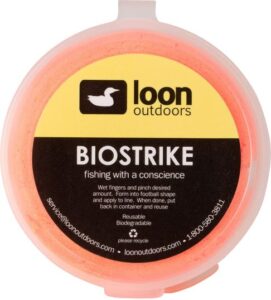
I love the idea of putty indicators, but in practice, it does not always live up to expectations.
There are several putty indicators on the market, and Loon Biostrike is the one I use most often. It is reusable, biodegradable, and environmentally friendly. I believe Orvis also makes a version but it has been a while since I have seen it in stock.
First the pros. I have seen stock trout confuse putty indicators for a pellet. Stock trout quite often will raise and take the putty by mistake. Now that I think about it, Indicator putty is not that different from the ‘powerbaits’ bait anglers use while fishing.
One of my biggest complaints is that when conditions are a bit warm. The putty can come loose and end up in the river. Meaning, I have to keep reapplying it. When the water temperature is cool, it does stay on the line better. In freezing conditions, the putty becomes as hard as a rock making it impossible to use.
Application is easy. With wet fingers, roll the putty into a tight ball then pinch it anywhere on the leader. Applying it around knots makes it less likely to come off while casting. If you want to move or remove the putty simply wet your finger and peel it off. It can be stored back in the container and used again. When fishing for wary fish I try to use the smallest ball of putty I can get away with.
The putty comes in a range of high visibility colors. I have not seen it in recent years, but there used to be a glow in the dark version for night fishing. The putty floats reasonably well and can be a good indicator when fishing small dry flies. For greater floatation, simply increase the amount of putty.
Overall, the biostrike indicators are easy and quick to apply, but they can also be easy to lose. They offer decent buoyancy and visibility. I feel it is a convenient way to quickly add or remove an indicator but it is not a product I frequently use.
| Buoyancy | 3/5 |
| Visibility | 4/5 |
| Stealth | 4/5 |
| Castability | 4/5 |
| Ease of use | 5/5 |
| Durability | 2/5 |
Palsa Pinch on Strike Indicators
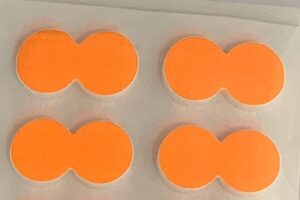
These were the first indicators I ever fished, and I still keep a few in my vest. They are easy but permanent. They are also very cheap hence why they were my initial purchase. For an angler on a budget, they are a great option.
These indicators can not be more simple. Just peel them off the backing and stick them around the leader. These strike indicators are made from foam with an adhesive backing. When lake fishing, one indicator is enough to float almost any fly. When fishing faster in turbulent water multiple indicators can be applied to increase buoyancy.
In very turbulent water, at times I find them quite hard to see. They float quite low in the water and, at times even become fully submerged.
They cast well, and do not kink the line. They land relatively gently on the water making them suitable for conditions where stealth and precision are required.
They are a one-time use indicator, they can not be repositioned. The adhesive is strong, and they do last many casts before coming off. In cold conditions, they can be a bit tricky to remove, and the adhesive leaves a sticky residue on the line.
I have also read reports of these littering the banks of trout rivers. They are not biodegradable so should be taken home and disposed of properly.
I always keep a few in my fly vest, but I rarely use them.
Pinch on foam indicators are cheap and fast to apply. But they are a one time use. They are decently buoyant and reasonably visible. Good budget option.
| Buoyancy | 3/5 |
| Visibility | 4/5 |
| Stealth | 4/5 |
| Castabiltiy | 4/5 |
| Ease of use | 5/5 |
| Durability | 4/5 |
Additional Information Regarding Indicator
Using a dry fly as an Indicator
We have all seen it. Our fly is gently drifting, and up comes a hungry trout eager to feed. The trout turns, opens its mouth wide and engulfs the indicator. Moments later, the trout spits it out before returning to the depths.
This is the primary reason many anglers’ indicator of choice is a dry fly. In calm conditions, a buoyant and visible dry fly kills two birds with one stone. Its bright wings play the role of an indicator, while at the same time it is a dry fly.
Best dry flies to use as an indicator.
Almost any dry fly can be used as an indicator. It only needs to be buoyant enough to stay afloat.
One of the most popular dry flies to use as an indicator is the royal wulff. The royal wulff does a good job at imitating mayflies and tiny terrestrial insects. Bright white hairs on the back make it very visible from afar. The Klinkhammer is a popular alternative.
Simulator, the simulator is a large fly with a lot of buoyancy. It represents large terrestrial insects. It works well during the hot summer months when there is plenty of insect activity. A cicada imitation is a good option during the Cicada hatch in New Zealand.
Foam Bugs. Small foam bug flies float well while resembling insects. One such example is the Unsinkabeetle. In small sizes they represent house flies, while the larger sizes represent bigger terrestrials.
Fly-fishing without an indicator.
It is possible to fly fish with nymphs and tiny wet flies without an indicator. There are several reasons to do so. The first is simplicity can be beautiful. Fishing with just a fly allows for more casting precision and graceful presentations.
In very clear water when casting to feeding fish. It is possible to see the trout take the nymph. When a trout opens its mouth to feed, you can briefly see the whites of its jaws flash. This is the indication to strike.
When sight fishing, the precision of presentation is of most importance. Fishing with an indicator not only makes precision casting harder, but it might also actually spook the fish.
When not to use indicators – fishing deep water.
When fishing deep water, you do not want an indicator. One of the primary purposes of an indicator is to keep the fly or nymph close to the surface. When trying to fish deep the indicator simply pulls the fly back to the surface. If you add even more weight, the indicator gets pulled under and creates unwanted drag.
Similarly, when actively fishing streamers indicators simply get in the way. The conventional streamer fishing method is to let it naturally swing across the current. Before giving it a few strips. With the line under tension, you should be able to feel any strike.
How to tell when a fish strikes?
Detecting strikes without an indicator can be difficult. It is a more advanced technique. Luckily, there are subtle ways to tell when a trout has taken your fly.
The most common solution is to closely watch the tip of the fly line. Just like an indicator It would ‘unnaturally’ jerk and move when a fish makes contact. It takes concentration and keen eyesight, but is a proven way to detect takes.
If you are sight fishing and can see the trout. Then watch for movement. It is normally possible to see a trout turn its head and open its mouth when taking a fly. This is the indication to strike.
Finally, is to fish by feel. With minimal slack in the line, you can feel the wiggle and weight of a hooked trout. Fishing by feel requires the line to be under tension. This method is often used when actively fishing with streamers.
Types of fly fishing indicators
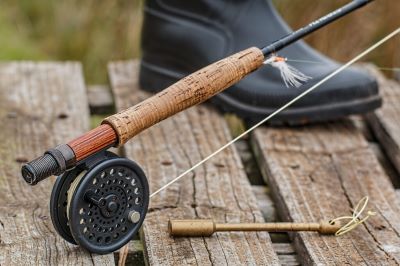
Fly fishing indicators come in many sizes, materials, and designs. Indicators are made from both natural and synthetic materials.
All fly fishing indicators need to float on the water surface and be highly visible. Ideally, they will also be lightweight, small, and streamline not to interfere with the cast or to cause additional drag which can spook fish.
Wool and Yarn: Wool is a traditional and time proven natural indicator. Greasy lanolin rich wool taken from the farmer’s fence often floats the best. A great option for anglers in the United Kingdom, Australia, and New Zealand.
Wool is naturally buoyant, thanks to its large surface area-to-weight ratio and naturally occurring lanolin oils. Eventually, it does become waterlogged, so applying oils and other floatants can help keep it afloat. Larger amounts of wool can be used to keep larger flies afloat.
White wool contrasts nicely against the dark water surface. Dyed wool in bright colors is even easier to see. Don’t use spun wool for an indicator natural fibers work best.
Various synthetic yarns share many of the same characteristics as wool. Some contain very lightweight and fluffy fibers. Synthetic yarn has grown in popularity because of its superior buoyancy and brighter colors.
Foam: Foam indicators have excellent buoyancy. They are typically small, brightly colored balls of foam that are attached to the fly line. Foam is best used in turbulent water with a lot of downward pressure.
Stick on: There are also little Stick-on Oval indicators. Being foam, they offer good buoyancy. They are among the quickest indicators to apply, just remove the back tape and pinch over the line. They are non-damaging to the line. although not as durable as some indicators. The adhesives will eventually fail.
One downside, they are difficult to remove or reposition along the line.
Hard plastic balls. Rigid plastic balls are a common indicator design. The line threads through a tiny hole, then secured with a plastic pin or toothpick. These indicators offer good visibility and excellent floatation.
Downsides include that you must remove the fly before threading through the leader. They are also relativity bulky, causing some disturbance to the presentation. These balls are best used in big water, strong current fishing where visibility and floatation are more important than stealth and precision.
Bio-putty: Is very easy and quick to apply. Simply form a small ball with it, and squeeze around the leader. The putty hardens on contact with cold water. Applying the putty to the knots helps prevent it flying off during casts.
Indicator setup – How to attach an indicator
Several factors determine the ideal location of an indicator. The most common factor is the depth you wish to fish the nymph. Placing an indicator towards the fly line allows the nymph to sink deeper into the water column, in contrast moving an indicator towards a nymph means it would drift just below the surface.
The most common method to attach a yarn or wool indicator to the leader is with an open indicator knot. This knot is very easy to tie but is quite weak. Avoid tying it in the tippet or thin portions of the leader.
Another variation is to tie a half hitch and thread the indicator through the loop then tighten. Then create a second loop over the half hitch securing it in place and preventing it from moving. Trim the yarn to the desired size and start fishing.
To remove the indicator, pull the indicator fibers apart which would open up the knot. All knots weaken the breaking strain of the line, so avoid tying them in lightweight tippet material.
New Zealand Indicator tool
The purpose of the New Zealand indicator tool is to install yarn or wool indicators.
An indicator tool is a finesse tool somewhat resembling a Latch Hook. The tool is easy to use. Start by creating a tiny loop in the line. Before inserting a tiny piece of tubing over the loop. Then thread the indicator fibers through the loop. Close the loop by squeezing the tiny tube against the yarn.
It is a knotless method for installing indicator yarn onto the fly line. The yarn is easy to remove by pulling the tubing away. It is also easy to move the indicator along the line. Quite a versatile little system. The tool makes it easy to use a precise amount of yarn. Allowing for bigger or smaller indicators.
Adjustable fly fishing indicator
Most fly-fishing indicators are adjustable, meaning they are easy to remove or relocate along the line.
The most adjustable indicators once installed are the hard plastic balls. It is possible to change their location by removing the locking pin and sliding the ball to its new location.
Yarn or wool indicators installed using the Indicator tool method are also very adjustable. Just loosen the locking tube, and slowly work the yarn along the line.
Bio-putty indicators need to be removed, then rolled into a new ball and reapplied. Bio-putty does slip so most users apply it around a knot in the line.
The less adjustable indicators are the stick-on pads and dry flies. Stick-on pads must be removed before replacing with a new one. Dry flies need to be re-tied to their new location.
Summary
I rate the CorQ as the best general-purpose indicator. They are very lightweight, so cast well, and are easy to present delicately reducing the chance of spooking wary fish. They are reasonably visible and float well. I also like how they are made out of wood rather than plastic. When purchased as part of a 3 pack, they come out to be $2.30 each.
When it is windy, and I want to keep turbulence during the cast to an absolute minimum the Oros strike indicator is a great alternative. They are even easier to attach and reposition along the line. They are made from biodegradable plastic. Slightly more expensive than the Corq, costing approximately $3.30 each.
When fishing for very shy trout in clear water conditions, I feel no indicator does a better job than a piece of yarn. Traditionally, tying on and moving yarn indicators was a bit fiddly, but the New Zealand Strike Indicator tool has revolutionized this aspect of fishing yarn.
Read more in my detailed descriptions below.
